Kii Audio Three Monitors

 When Bill Parish of GTT Audio and Video asked me to review his Kii Audio Three active loudspeakers, my first response was, “What took you so long to ask?” You see, I’d been keeping an eye on this German loudspeaker since its debut at the Munich High End show some years ago. The only person more excited than I was at that time was Parish himself.
When Bill Parish of GTT Audio and Video asked me to review his Kii Audio Three active loudspeakers, my first response was, “What took you so long to ask?” You see, I’d been keeping an eye on this German loudspeaker since its debut at the Munich High End show some years ago. The only person more excited than I was at that time was Parish himself.
Over the next few years, I heard the Kii’s under various conditions, including tough venues like audio shows. In each case, the Audio Threes always impressed me. And when Parish told me he’d become the US distributor, I was glad for him and myself. Bill lives not too far away, and when he got around to asking me how soon I’d like to hear them in my home, I said, “Yesterday would be great!” He dropped them off a few days later. I couldn’t wait to set them up!
After Parish left, I opened the two rather large boxes that held each Kii Audio Three monitor. These little tykes have a total of six drivers! They are located on all four sides of their beautifully sculpted, piano-finish cabinet. The front has a 5″ aluminum-coned midrange and 1″ horn-loaded dome tweeter. Each side has a single 6″ aluminum-coned woofer. The back has two rear-firing 6″ drivers. The Audio Three’s four-sided driver approach reminds me of the intense love affair I had with the Audio Physic Calderas (albeit these are a miniaturized version).

Due to this unique driver approach, special care is required when handling. Fit and finish are superb as one would expect from a German-designed product. The Kii Audio Threes are small in stature (16″ x 8″ x 16″) and weigh 33 lbs each, heavier than one would expect. There’s a reason for this: the six drivers are powered by six DSP-based 250 watt NCore digital amplifiers. Yes folks, that’s 1500 watts of Class D amplification, compliments of Hypex designer Bruno Putzey. The supplied Kii Audio solid steel stand (photo above) is matched for the Kii Audio Three’s base to sit snugly onto. Standing 27 1/2″ tall, they’re optimized for the ideal listening position from either your sofa or chair.
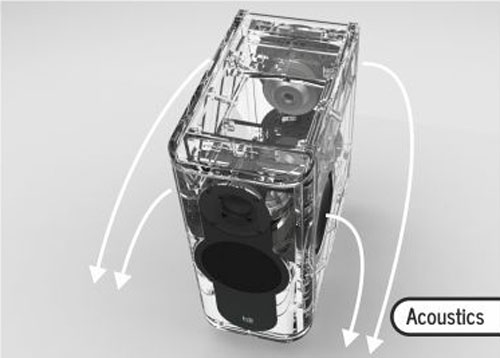
The Kii Audio Three is designed with Active Wave Focusing technology, which the manufacturer describes as follows: A loophole in acoustics suggests that small directive speakers are possible—if you have enough drivers and feed them the exact right signal. The THREE has a total of 6 (six) ways, front, side, and rear, working together to throw the sound in one direction only without relying on a baffle. The THREE’s ability to direct bass is comparable to, but much better controlled than, that of a traditional speaker several meters wide.
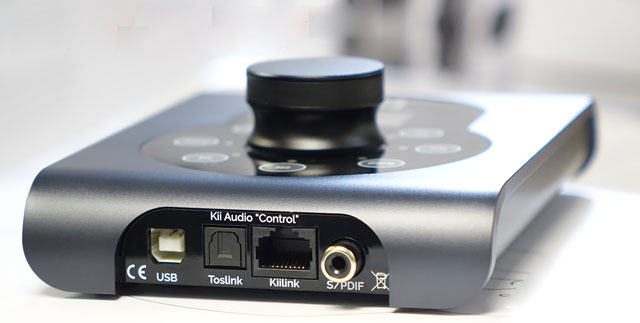
A series of digital and analogue inputs (XLR) are located on the Kii Audio Three’s rear bottom panel, along with a male IEC plug (fortunately, Parish supplied a pair of generic AC cords, as bulky audiophile AC cords will not fit). A pair of toggle switches allows the user to choose between right/left channel and/or digital/analogue input. An RJ45 input jack (or CAT5) allows direct connectivity to and from the loudspeakers to the Kii Controller, which serves as the head unit. The Kii Controller features several digital inputs, including coax, Toslink, USB, and XLR, as well as a volume control, all of which are accessible through its rotary dial control. Additionally, the Kii Controller’s sophisticated settings can be intimidating at first glance (14 presets, contour attenuation, low-frequency boundary compensation). Still, fortunately, in my case, the system performed quite admirably in Flat mode. Inputs include PCM at 24/384 kHz and DSD64/DSD128 via USB.
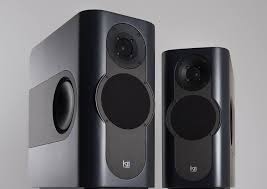 Most music lovers I know listen either in their living room or a similar-sized space. Few have large spaces, dedicated or not. What makes the Kii Audio Threes so cool is that they’re optimized to work remarkably well in a host of settings, compliments of built-in room compensation software. For example, the boundary controller adjusts the bass depending on proximity to the back and side walls. I set up the Kii Audio Threes, using the supplied speaker stands, at about four feet from the rear and about three feet from the side walls. Using my Sooloos Music Server as a pure digital source feeding the Kii Controller, I had the system fully operational in 20 minutes. Fine adjustments to the Kii Controller produced the best bass response I’ve ever heard from a compact monitor in my dining room.
Most music lovers I know listen either in their living room or a similar-sized space. Few have large spaces, dedicated or not. What makes the Kii Audio Threes so cool is that they’re optimized to work remarkably well in a host of settings, compliments of built-in room compensation software. For example, the boundary controller adjusts the bass depending on proximity to the back and side walls. I set up the Kii Audio Threes, using the supplied speaker stands, at about four feet from the rear and about three feet from the side walls. Using my Sooloos Music Server as a pure digital source feeding the Kii Controller, I had the system fully operational in 20 minutes. Fine adjustments to the Kii Controller produced the best bass response I’ve ever heard from a compact monitor in my dining room.
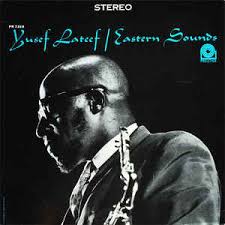 Yusef Lateef’s haunting Love Theme from Spartacus and Blues from the Orient, from his “Eastern Sounds” CD, make this stellar 1962 jazz recording one of my all-time favorites and certainly the best from Yusef himself. As the title track suggests, the music appears to hail from the Far East. It is contemporary in terms of melody, but interspersed with unconventional instruments that showcase Yusef’s exceptional abilities on flute, oboe, and tenor saxophone. Heard through the Kii Audio Threes, there is a sense of space that is rarely achieved from stand-mounted monitors. In addition, the bass was surprisingly taut and well detailed, while the overall weight sounded as though it was coming from a much larger enclosure. Image size and height was spot on in a solid three-dimensional backdrop. The sound, even when played at reasonably loud levels, proved exceptionally clean and devoid of stress or strain: never excessive or exaggerated in tone or textures.
Yusef Lateef’s haunting Love Theme from Spartacus and Blues from the Orient, from his “Eastern Sounds” CD, make this stellar 1962 jazz recording one of my all-time favorites and certainly the best from Yusef himself. As the title track suggests, the music appears to hail from the Far East. It is contemporary in terms of melody, but interspersed with unconventional instruments that showcase Yusef’s exceptional abilities on flute, oboe, and tenor saxophone. Heard through the Kii Audio Threes, there is a sense of space that is rarely achieved from stand-mounted monitors. In addition, the bass was surprisingly taut and well detailed, while the overall weight sounded as though it was coming from a much larger enclosure. Image size and height was spot on in a solid three-dimensional backdrop. The sound, even when played at reasonably loud levels, proved exceptionally clean and devoid of stress or strain: never excessive or exaggerated in tone or textures.
And consider that there’s no need for loudspeaker cables and/or interconnects. Just a digital cable and power cords. One might think that 1,500 watts is way too much power for such a small loudspeaker, but on first listen, one can hear an incredible sense of assuredness that belies its small stature. Simply put, there’s a lot of fight in this small dog. I have been enjoying the Greg Allman and the Allman Brothers Band of late. “Live at the Fillmore East,” especially. Listening to a rock band is not my usual cup of tea but I find their music enjoyable and toe-tapping. In fact, I was pleasantly surprised to hear how much soul this group actually possesses.
 The Kii Three’s made my adventure in classic rock that much more enjoyable. The sound seemed to fill up my entire listening space, but again, it presented itself neither harsh nor forward. For example, Stormy Monday was the track playing when a few of my friends arrived for a listening session. They had no idea the Kii Audio Threes were in the system. At first, they looked at me wonderingly, wondering which loudspeakers were actually playing? Standing beside them was a pair of rather large and expensive floor standers (Bache Audio 002AB, reviewed here). The fact that a pair of little stand-mounted monitors could fill up my 18′ x 17′ x 9′ dining room with such weight and resolution was spellbinding.
The Kii Three’s made my adventure in classic rock that much more enjoyable. The sound seemed to fill up my entire listening space, but again, it presented itself neither harsh nor forward. For example, Stormy Monday was the track playing when a few of my friends arrived for a listening session. They had no idea the Kii Audio Threes were in the system. At first, they looked at me wonderingly, wondering which loudspeakers were actually playing? Standing beside them was a pair of rather large and expensive floor standers (Bache Audio 002AB, reviewed here). The fact that a pair of little stand-mounted monitors could fill up my 18′ x 17′ x 9′ dining room with such weight and resolution was spellbinding.
 If you’re a music lover who wants the best sound possible in an small, attractive enclosure—then look no further. The Kii Audio Three monitor is a loudspeaker designed for music connoisseurs rather than typical audiophiles. You see, the Kii Three ask nothing from you except to sit down and listen to them. However, if you’re a stickler for the perfect sound, you can’t tinker with the various presets and contours for countless sonic opportunities. Once again, I found that a slight 3 dB boost in the bass allowed me to achieve the best performance I’ve heard from a monitor in my dining room thus far. Furthermore, the manufacturer’s primary objective was to enable you to enjoy your favorite music directly from its source in an uncomplicated manner. And as far as I can tell, the company has surpassed this goal. Just imagine being able to plug your CD player directly into a loudspeaker? Well, the Kii Audio Three allows you to do just that. The sonic results relay an incredibly clean, fast, and dynamic sound that fills spaces that you’d never believe possible from such a compact design. It requires the bare minimum of cables and equipment, yet surpasses any other loudspeaker I’ve heard in terms of sonic excellence at its size and price point. Highly recommended and easily awarded my 2017 Most Wanted Component Publisher’s Choice!
If you’re a music lover who wants the best sound possible in an small, attractive enclosure—then look no further. The Kii Audio Three monitor is a loudspeaker designed for music connoisseurs rather than typical audiophiles. You see, the Kii Three ask nothing from you except to sit down and listen to them. However, if you’re a stickler for the perfect sound, you can’t tinker with the various presets and contours for countless sonic opportunities. Once again, I found that a slight 3 dB boost in the bass allowed me to achieve the best performance I’ve heard from a monitor in my dining room thus far. Furthermore, the manufacturer’s primary objective was to enable you to enjoy your favorite music directly from its source in an uncomplicated manner. And as far as I can tell, the company has surpassed this goal. Just imagine being able to plug your CD player directly into a loudspeaker? Well, the Kii Audio Three allows you to do just that. The sonic results relay an incredibly clean, fast, and dynamic sound that fills spaces that you’d never believe possible from such a compact design. It requires the bare minimum of cables and equipment, yet surpasses any other loudspeaker I’ve heard in terms of sonic excellence at its size and price point. Highly recommended and easily awarded my 2017 Most Wanted Component Publisher’s Choice!

clement perry
Specifications
Price: $12,900 with Kii Controller
Ultra compact controller/preamp/USB Interface for Kii THREE Loudspeaker.
Additional Audio Inputs:
1 x SPDIF
1 x TOSLINK
1 x USB (up to PCM 24/384kHz and DSD64/DSD128)
KiiLink Output: Power and Data Connection to Kii THREE Master speaker
Capacitive Touch Buttons:
Direct Source Access (SPDIF, TOSLINK, USB, XLR)
Preset (up to 6, user definable)
Exit/Enter (Menu Navigation)
OLED Display (full colour)
Size: 11cm x 5cm x16cm (W x H x L)
Weight: 380g
(We have tested the USB input with streamers and servers from Melco, Lumin, Aurender and Auralic with excellent results.)
US Distributor: GTT Audio Video
Website: www.gttaudio.com/Home.html
Stereo Times Masthead
Publisher/Founder
Clement Perry
Editor
Dave Thomas
Senior Editors
Frank Alles, Mike Girardi, Russell Lichter, Terry London, Moreno Mitchell, Paul Szabady, Bill Wells, Mike Wright, and Stephen Yan,
Current Contributors
David Abramson, Tim Barrall, Dave Allison, Ron Cook, Lewis Dardick, John Hoffman, Dan Secula, Don Shaulis, Greg Simmons, Eric Teh, Greg Voth, Richard Willie, Ed Van Winkle, Rob Dockery, Richard Doron, and Daveed Turek
Site Management Clement Perry
Ad Designer: Martin Perry




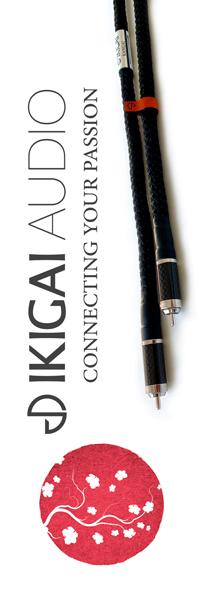
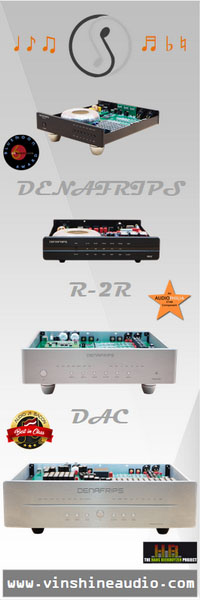
Be the first to comment on: Kii Audio Three Monitors